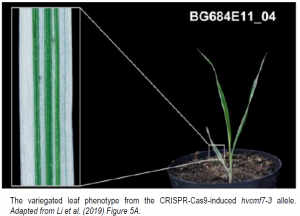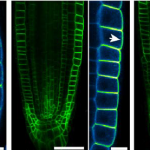The White Stripes Featuring ALBOSTRIANS, a Chloroplast-Localized CCT Domain Protein
Variegation in different organ types has been of great interest to biologists. The study of pigment variegation in maize kernels led to the discovery of transposable elements (McClintock, 1950), whereas the study of eye pigment variegation in Drosophila has led to interesting insights into chromatin regulation (Elgin and Reuter, 2013). Leaf variegation, in which leaves contain both normal and defective chloroplasts, offers an excellent system to study chloroplast biogenesis, and anterograde and retrograde signalling. The barley mutant albostrians is a classic variegation mutant and studies on it have stimulated different aspects of chloroplast research (Börner, 2017); however, the underlying gene has been unknown since its initial characterization more than 50 years ago (Hagemann and Scholz, 1962), until now.
 Here, Li et al. have cloned the ALBOSTRIANS (HvAST/ HvCMF7) gene and identified its product as the first CCT domain containing protein to localize to the chloroplast. The authors initially identified HvCMF7 as the putative HvAST gene through map-based cloning of the classic mutant, now designated hvcmf7-1, which the authors predicted to encode a truncated protein. Subsequently, they generated a series of EMS-induced TILLING alleles of the candidate gene HvCMF7 and identified one mutant that segregated for albinism. This mutant, designated hvcmf7-2, harboured a lesion that introduced a premature stop codon, which was predicted to produce a truncated protein relative to both the HvCMF7 and hvcmf7-1 alleles. Notably, hvcmf7-1 and hvcmf7-2 were both deficient in chloroplast ribosomal RNA and lacked identifiable thylakoids and granum stacks in the cells of albino leaves. An allelism test confirmed that these mutants were alleles of the same gene. Furthermore, CRISPR-Cas9-mediated genome-editing of ‘wild-type’ barley plants introduced a lesion into the HvCMF7 gene, denoted hvcmf7-3, that generated a premature stop codon in a similar location to the hvcmf7-1 lesion, which also resulted in plants with variegated leaves (Figure). The closest homolog of HvCMF7 in A. thaliana is CHLOROPLAST IMPORT APPARATUS 2 (AtCIA2), both of which encode CCT domain-containing proteins. AtCIA2 is a nucleus-localized transcription factor that promotes the expression of translocon and ribosomal genes (Sun et al. 2001); however, the localization of HvCMF7 to the chloroplasts (and possibly also to the nucleus) strongly suggests that it has a function outside of the nucleus. Interestingly the CCT domain of HvCMF7 is partially dispensable, as both hvcmf7-1 and hvcmf7-3 plants lack this protein–protein interaction domain and were still able to produce functional chloroplasts, albeit with reduced efficiency.
Here, Li et al. have cloned the ALBOSTRIANS (HvAST/ HvCMF7) gene and identified its product as the first CCT domain containing protein to localize to the chloroplast. The authors initially identified HvCMF7 as the putative HvAST gene through map-based cloning of the classic mutant, now designated hvcmf7-1, which the authors predicted to encode a truncated protein. Subsequently, they generated a series of EMS-induced TILLING alleles of the candidate gene HvCMF7 and identified one mutant that segregated for albinism. This mutant, designated hvcmf7-2, harboured a lesion that introduced a premature stop codon, which was predicted to produce a truncated protein relative to both the HvCMF7 and hvcmf7-1 alleles. Notably, hvcmf7-1 and hvcmf7-2 were both deficient in chloroplast ribosomal RNA and lacked identifiable thylakoids and granum stacks in the cells of albino leaves. An allelism test confirmed that these mutants were alleles of the same gene. Furthermore, CRISPR-Cas9-mediated genome-editing of ‘wild-type’ barley plants introduced a lesion into the HvCMF7 gene, denoted hvcmf7-3, that generated a premature stop codon in a similar location to the hvcmf7-1 lesion, which also resulted in plants with variegated leaves (Figure). The closest homolog of HvCMF7 in A. thaliana is CHLOROPLAST IMPORT APPARATUS 2 (AtCIA2), both of which encode CCT domain-containing proteins. AtCIA2 is a nucleus-localized transcription factor that promotes the expression of translocon and ribosomal genes (Sun et al. 2001); however, the localization of HvCMF7 to the chloroplasts (and possibly also to the nucleus) strongly suggests that it has a function outside of the nucleus. Interestingly the CCT domain of HvCMF7 is partially dispensable, as both hvcmf7-1 and hvcmf7-3 plants lack this protein–protein interaction domain and were still able to produce functional chloroplasts, albeit with reduced efficiency.
Further experiments, such as protein localization and protein–protein interaction experiments, will help to reveal whether HvCMF7 has functions in common with AtCIA2 and what its functions in the chloroplast are. Now that the identity of this gene has been revealed, further examination of its functions is possible, which promises to lead to insights into chloroplast biogenesis and cross-communication between the nucleus and chloroplast and to new roles of CCT domain proteins.
REFERENCES
Börner T. (2017) The discovery of plastid-to-nucleus retrograde signalling – a personal perspective. Protoplasma 254, 1845-1855
Elgin SC and Reuter G. (2013) Position effect variegation, heterochromatin formation, and gene silencing in Drosophila. Cold Spring Harbor Perspectives in Biology 5:8
Hagemann R, and Scholz F. (1962) Ein Fall Gen-induzierter Mutationen des Plasmotyps bei Gerste. Züchter 32, 50-59.
Li M, Hensel G, Mascher M, Melzer M, Budhagatapalli N, Rutten T, Himmelbach A, Beier S, Korzun V, Kumlehn J, Börner B, and Stein N. (2019) Leaf variegation and impaired chloroplast development caused by a truncated CCT domain gene in albostrians Barley. Plant Cell. doi: https://doi.org/10.1105/tpc.19.00132
McClintock B. (1950) The origin and behaviour of mutable loci in maize. Proceedings of the National Academy of Sciences U.S.A. 36:6, 344-355
Sun CW, Chen LJ, Lin LC, and Li HM. (2001). Leaf-specific upregulation of chloroplast translocon genes by a CCT motif-containing protein, CIA2. Plant Cell 13, 2053-2061.



